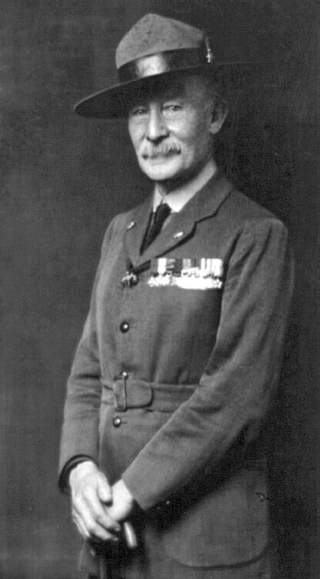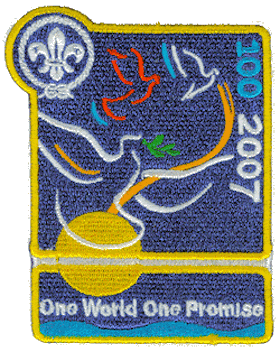
Scouting, also known as the Scout Movement, is a worldwide youth social movement employing the Scout method, a program of informal education with an emphasis on practical outdoor activities, including camping, woodcraft, aquatics, hiking, backpacking, and sports. Another widely recognized movement characteristic is the Scout uniform, by intent hiding all differences of social standing in a country and encouraging equality, with neckerchief and campaign hat or comparable headwear. Distinctive uniform insignia include the fleur-de-lis and the trefoil, as well as merit badges and other patches.

Lieutenant-General Robert Stephenson Smyth Baden-Powell, 1st Baron Baden-Powell, was a British Army officer, writer, founder of The Boy Scouts Association and its first Chief Scout, and founder, with his sister Agnes, of The Girl Guides Association. Baden-Powell wrote Scouting for Boys, which, with his previous books, his 1884 Reconnaissance and Scouting and his 1899 Aids to Scouting for N.-C.Os and Men and The Scout magazine helped the rapid growth of the Scout Movement.

A neckerchief, sometimes called a necker, kerchief or scarf, is a type of neckwear associated with those working or living outdoors, including farm labourers, cowboys and sailors. It is most commonly still seen today in the Scouts, Girl Guides and other similar youth movements. A neckerchief consists of a triangular piece of cloth or a rectangular piece folded into a triangle. The long edge is rolled towards the point, leaving a portion unrolled. The neckerchief is then fastened around the neck with the ends either tied or clasped with a slide or woggle.

Brownsea Island is the largest of the islands in Poole Harbour in the county of Dorset, England. The island is owned by the National Trust with the northern half managed by the Dorset Wildlife Trust. Much of the island is open to the public and includes areas of woodland and heath with a wide variety of wildlife, together with cliff top views across Poole Harbour and the Isle of Purbeck.

The world scout emblem, used worldwide by Scouts and many Scout organizations within the Scout Movement is the fleur-de-lis, commonly with a five-point star in each outer lobe. This emblem was adopted by Scouts from the inception of the Scout Movement and is used, in various forms, by many Scout organizations.
Kenneth McLaren DSO, (1860–1924) was a Major in the 13th Hussars regiment of the British Army. After his military service he assisted with the growth of the Scouting movement founded by his friend Robert Baden-Powell.

Scouts' Day or Guides' Day is a generic term for special days observed by members of the Scouting movement throughout the year. Some of these days have religious significance, while others may be a simple celebration of Scouting. Typically, it is a day when all members of Scouting will re-affirm the Scout Promise.

The Scouting 2007 Centenary comprised celebrations around the world in which Scouts celebrated 100 years of the world Scout movement. The original celebrations were focused on the United Kingdom, such as the camp on Brownsea Island, the birthplace of Scouting, and the 21st World Scout Jamboree in Chelmsford, Essex.

Brownsea Island Scout camp, is a historic Scout campsite on Brownsea Island in Poole Harbour in southern England, which was the site of Robert Baden-Powell's 1907 experimental camp for boys to test ideas for his book Scouting for Boys, which led to the rapid growth of the Scout movement. Boys from different social backgrounds participated from 1 to 8 August 1907 in activities around camping, observation, woodcraft, chivalry, lifesaving and patriotism.

World Thinking Day, formerly Thinking Day, is celebrated annually on 22 February by all Girl Guides and Girl Scouts. It is also celebrated by Scout and Guide organizations around the world. It is a day when they think about their "sisters" in all the countries of the world, the meaning of Guiding, and its global impact.

The Skolta Esperanto Ligo (SEL) brings together Esperanto-speaking Scouts from all over the world.

The 3rd World Scout Jamboree was held in 1929 at Arrowe Park in Upton, near Birkenhead, Wirral, United Kingdom. As it was commemorating the 21st birthday of Scouting for Boys and the Scouting movement, it is also known as the Coming of Age Jamboree. With about 30,000 Scouts and over 300,000 visitors attending, this jamboree was the largest jamboree so far.

The left-handed Scout handshake is a formal way of greeting other Scouts and is used by members of Scout and Guide organizations around the world. The handshake is made with the hand nearest to the heart and is offered as a token of friendship. In most situations, the handshake is made firmly, without interlocking fingers, and many organizations only use this handshake when both people are in uniform. There are some variations of the handshake between national Scouting organizations and also within some program sections.

Scouting for Boys: A handbook for instruction in good citizenship is a book on Boy Scout training, published in various editions since 1908. Early editions were written and illustrated by Robert Baden-Powell with later editions being extensively rewritten by others. The book was originally a manual for self-instruction in observation, tracking and woodcraft skills as well as self-discipline and self-improvement, about the British Empire and duty as citizens with an eclectic mix of anecdotes and unabashed personal observations and recollections. It is pervaded by a degree of moral proselytizing and references to the author's own exploits. It is based on his boyhood experiences, his experience with the Mafeking Cadet Corps during the Second Boer War at the siege of Mafeking, and on his experimental camp on Brownsea Island, England.

The Crystal Palace Rally was a gathering of Boy Scouts and Girl Scouts at the Crystal Palace in London on Saturday, 4 September 1909. The rally demonstrated the rapid popularisation of the Scout Movement with an estimated 11,000 boys attending with the prominent presence of Girl Scouts also being significant for the start of Girl Scouts and Girl Guides. The rally was held a year and a half after the publication of Scouting for Boys and The Scout magazine, and two years after Robert Baden-Powell's demonstration Brownsea Island Scout Camp.

Girl Guides is a worldwide movement, originally and largely still designed for girls and women only. The movement began in 1909, when girls requested to join the then-grassroots Boy Scout Movement.

B-P's footprint is a casting, usually in bronze or brass, of the right foot of Lord Baden-Powell, the founder of the Scout and Guide Movements, who is known as "B-P." The idea is that people may put their foot into this casting, so that they can say that they have "walked in the footsteps of B-P."

A statue of Robert Baden-Powell, founder of Scouting, is installed on the Quay in Poole harbour, Dorset on the south coast of England. The statue, erected in 2008, is a life-size bronze of Robert Baden-Powell by sculptor David Annand. It portrays Baden-Powell in his scout uniform, seated on a log as if for a campfire, with a pair of log seats either side which "allow easy access for photo opportunities".

Lookwide Camp is recognised as the first official Scout camp. From 22 August to 4 September 1908, Baden-Powell ran a camp near Humshaugh, England. While Brownsea Island was the site of the experimental camp run by Baden-Powell in 1907, the Humshaugh camp had thirty Boy Scouts from around the United Kingdom who were members of recognised Scout Troops who followed the Scout Method and Scout Law as developed by Baden-Powell and published in his Scouting for Boys.


















